TRADITIONAL MOSQUE ROOF FINIALS IN MELAKA
Traditional Mosque Roof Finials (Mahkota Atap Masjid) in Melaka, Malaysia
Ros Mahwati Ahmad Zakaria
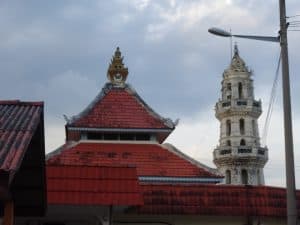
Mahkota Atap Masjid Tanjung Kling
Melaka (Melaka) was one of the most prosperous and powerful early sultanates in Southeast Asia. Founded in the early fifteenth century, it established new models of Malay-Muslim culture that continued to influence expressions of Islam across Southeast Asia for centuries thereafter. One particular manifestation of Melaka’s distinctive style of Islamic aesthetics can be found in the ornamentation of mosque roof finials, or mahkota atap masjid.
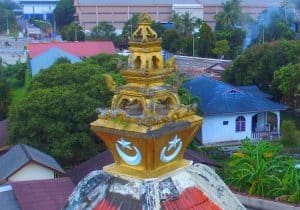
Mahkota Atap Masjid Kampung Kling
Various forms of architectural ornament adorning the roofs of traditional buildings are found across the region, and referred to by a range of different local names such as mustaka, tiang atas, and hiasan puncak in the islands of Indonesia, as well as buah buton, buah gutong and tunjuk langit on the Malay Peninsula. The term mahkota (crown) is used here to convey a sense of the exquisite design crowning the top of traditional mosques in Melaka as a symbolic mark of the sacred status of the mosque for the Muslim community.
In the tradition of Melaka, mahkota atap masjid were usually made from an admixture of sea corals and eggs that could be moulded into elaborate shapes. This traditional building material is highly durable. Some examples have lasted for hundreds of years and to this day are still standing firm on the top of traditional mosques in Melaka. Others are constructed of metal. Examples dating from the 18th to the 20th centuries still visible today are manifestations of the cultural heritage of Melaka, exhibiting aspects of unique design symbolizing the local cultural identity of this historic port along the maritime routes connecting East, Southeast, and South Asia.
Thirty-eight mosques have been identified with traditional mahkota atap masjid in Melaka, with six in Jasin, eighteen in Melaka Tengah and fourteen in Alor Gajah.
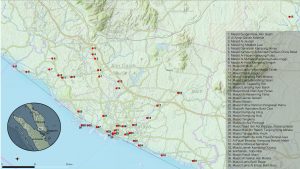
Mosques with mahkota atap in Melaka
Our research discovered examples of mahkota atap masjid containing a range of basic structures with multiple registers ranging from two to seven tiers. Most mahkota atap mesjid have five main tiers: 1) a top knot (puncak), 2) a head (kepala), 3) an upper body (badan atas), 4) a lower body (badan bawah) and 5) a base (kaki/ tapak). The most elaborate mahkota have seven tiers with the addition of ‘shoulders’ (bahu) and a sub-base (tapak kedua). These tiers generally decrease in size from the base to the puncak. In this vertical profile, mahkota atap masjid might be seen as sharing some basic taxonomy with early Muslim gravestones in Southeast Asia.
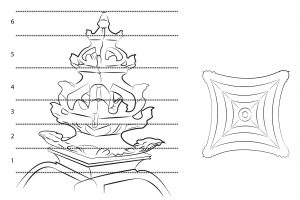
Six tiers of Mahkota atap
The design of the mahkota atap of traditional mosques in Melaka incorporates a range of characteristic features selectively deployed in distinctive forms. Our project has constructed a typology of four types of mahkota atap masjid found on mosques in the region of Melaka. The first type is a solid structure design (Struktur Padat) with four surfaces and without any holes or opening in the design. The second incorportates small openings or hollows in a semi-solid structure design (Struktur separuh padat). The third basic type is a skeleton design (Struktur kerangka konkrit) with more clearly defined cuts to reveal a more open structure. Finally, metal frame designs (Struktur bingkai logam) constructed with iron rods that have been bent into an ornamental configurations constitute a fourth basic type. In terms of motifs often used in the mahkota atap in Melaka, the ivy (sulur daun) and lotus (bunga Teratai) are the most popular. However, other motifs can also be found on the mahkota atap masjid in Melaka.
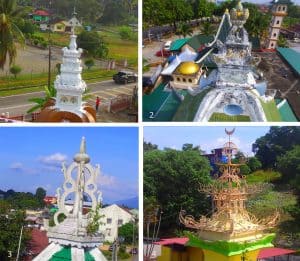
Typology of Mahkota Atap Masjid: 1) Solid Structure, 2) Semi-Solid Structure, 3), Skeleton Structure, 4) Metal Frame Structure
From 2018-2021, I led a research project entitled “The Preservation of Traditional Mosque Roof Finial (Mahkota Atap Masjid) Design in Melaka as a Local Islamic Art” (Universiti Kebangsaan Malaysia: Grant Code GUP 2018-001). The project was designed to document and preserve this distinctive form of cultural heritage. Today, mahkota atap masjid are in danger of vanishing as a design element in local mosque architecture due to the increased demand for ‘modern style’ mosques, as well as popular misunderstandings about local traditions of Islamic ornament.
The variety and unique design of Mahkota Atap Masjid in Melaka dating from the 18th century to the 20th century symbolize the distinctive of the Malay community in Melaka, combining centuries of Islamic tradition in dynamic interaction with a complex constellation of cultural influences. The Malay Muslim cultre of Melaka is, moreover, situated within a context of cultural pluralism that also includes the Baba Nyonya and Chettiar communities, with whom Melaka’s Muslims have been interacting for centuries. In fact, most of the mosques, especially in the district of Melaka Tengah, are located in areas that are also home to many non-Muslim residents. Mahkota Atap Masjid thus represent engagement with culturally complex visual languages shared by divers communities in the development of a material form expressing Islamic values through the adornment of a house of prayer. In sum, they present a striking reflection of the multi-cultural mosaic produced over the course of Melaka’s rich history.
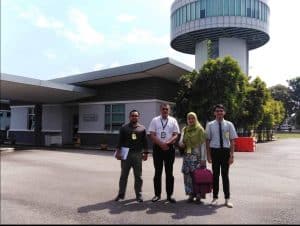
The Director of the Civil Aviation Authority Malaysia in Melaka (CAAM) and the research team members after the briefing session on the project
The project team consisted of two academics (Dr Ros Mahwati Ahmad Zakaria (PI) and Associate Professor Dr Zuliskandar Ramli), and a graduate research assistant (Nurfarahhana Ismail). Over the course of our work, we managed to collect important data on the location of traditional mosques with surviving mahkota atap masjid, and developed a taxonomy of the design and ornamental aspects of these features on mosques in three districts of Melaka: Jasin, Melaka Tengah and Alor Gajah Mosques at each location were visited and the locations registered with MyGpS / Velocimeter applications, which were then synched with GoogleEarth. With permission from local authorities, the mahkhota atap masjid were then photographed using a drone to provide a detailed visual documentation of the design of the mahkota atap, as well as providing a 360◦ aerial view of the mosque in its local surroundings.
Further information on Melaka’s heritage of mahkota atap masjid will soon be published by Penerbit Universiti Kebangsaan Malaysia in a book entitled Seni Islam Alam Melayu: Reka Bentuk Mahkota Atap Masjid Warisan Negeri Melaka.

